A History of Football Kit Design in England and Scotland
(8) The Miracle of Polyester 1980-1989
Although replica shirts in adult sizes started to appear in club shops this remained a niche market. Supporters might buy a top to wear down the pub with their mates but it was not considered appropriate to wear one to a match. Even when a team reached an important cup final fans showed their allegiance in the traditional way with scarves, hats, favours and perhaps, fancy dress. In their study of the development of the replica kit market (Taylor & Francis Online), co-authors Christopher Stride, Nick Catley and Joe Headland estimate that in the period 1980-1987 only 3-4% of spectators wore replica shirts to games. There was a period of rapid growth between 1987 and 1991 followed by a sharp surge in 1992-93.
The Sponsorship Boom
Although shirt sponsorship was now permitted, the television broadcasting companies refused to show sponsored shirts in their weekend highlights programmes and the teams involved had to play in unsponsored 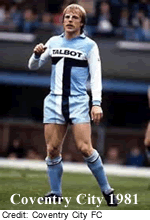 tops. BBC's Match of the Day featured just two matches each Saturday but the eleven regional ITV companies each had their own programmes that featured two matches each so the impact was significant and inhibited the growth of sponsorship
tops. BBC's Match of the Day featured just two matches each Saturday but the eleven regional ITV companies each had their own programmes that featured two matches each so the impact was significant and inhibited the growth of sponsorship 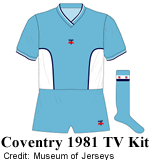 as a revenue stream for clubs.
as a revenue stream for clubs.
Coventry City, always prepared to innovate, came up with the novel idea of integrating the logo of the Talbot car manufacturing company into the design of their strip. Even with the word "Talbot" removed, the sponsor's logo would be unmistakeable. The TV companies were having none of it and the Sky Blues were banned from the nation's screens until they introduced an acceptable alternative.
In 1983 a deal was struck that allowed live football to be broadcast for the first time since 1960. The BBC and ITV companies could each show five matches live and in full during the 1983-84 season. At the same 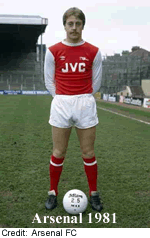 time sponsored shirts would be televised for the first time although the maximum size would be restricted to 16 square inches, half the size of the non-televised standard. This restriction was lifted in 1986-87.
time sponsored shirts would be televised for the first time although the maximum size would be restricted to 16 square inches, half the size of the non-televised standard. This restriction was lifted in 1986-87.
This decision instantly boosted the value of sponsorship contracts which were rapidly adopted across the Football League and in Scotland. By 1985-86, all but ten of the league's 92 members had a shirt sponsor in place. Not every club embraced the opportunity with enthusiasm, however. When sponsorship was authorised in 1978 Arsenal's management announced that their iconic team shirt would never be soiled by anything so vulgar as a commercial sponsor. Everything has its price however and an offer by electronics giant JVC of a three-year deal worth £500,000 (£1.76m in 2023 prices) was enough for the board to abandon their scruples in 1981.
The Future is Plastic
Perhaps the most significant innovation of this decade was the introduction of polyester as the fabric of choice for football shirts. Artificial fabrics had appeared earlier but did not catch on. Admiral had 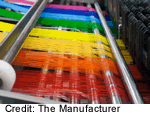 introduced polyester tops in the previous decade and these had proved popular with professionals because they were lighter than cotton and, unlike natural fibres, did not retain moisture. Furthermore polyester is highly durable and capable of absorbing the repeated vigorous and repetitive movement of athletes without losing its shape. On the other hand polyester is less breathable than cotton, can feel uncomfortable against the skin and makes the wearer sweat more. A further disadvantage is that the production of polyester fabric is energy intensive, consumes oil, produces large quantities of greenhouse gases and cannot be readily recycled. It is thought that it may take 200 years or more for polyester to degrade naturally but as it has not been around that long, no-one can be sure.
introduced polyester tops in the previous decade and these had proved popular with professionals because they were lighter than cotton and, unlike natural fibres, did not retain moisture. Furthermore polyester is highly durable and capable of absorbing the repeated vigorous and repetitive movement of athletes without losing its shape. On the other hand polyester is less breathable than cotton, can feel uncomfortable against the skin and makes the wearer sweat more. A further disadvantage is that the production of polyester fabric is energy intensive, consumes oil, produces large quantities of greenhouse gases and cannot be readily recycled. It is thought that it may take 200 years or more for polyester to degrade naturally but as it has not been around that long, no-one can be sure.
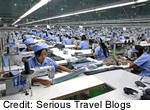 From the manufacturers' point of view, the main advantage of polyester was that it could be produced in huge quantities very cheaply albeit at a significant cost to the environment. Outside of the nascent environmental movement, however, these issues mattered little to the general public.
From the manufacturers' point of view, the main advantage of polyester was that it could be produced in huge quantities very cheaply albeit at a significant cost to the environment. Outside of the nascent environmental movement, however, these issues mattered little to the general public.
As polyester became the fabric of choice for sportswear, new technologies emerged that took full advantage of its properties. Direct dye sublimation printing involves the application of inks to a substrate that is then heated to set the dye. The introduction of digital technology allowed finer detailing to be applied to the new fabrics in a way that was not possible with cotton.
Jacquard looms had been around since the early 19th century, using punched cards to control the weaving of complex patterns into fabric. In the 1980s, computers replaced the punched cards enabling novel patterns to be woven into the fabric of sportswear.
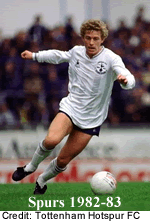 The Eighties brought a boom in the sports-leisure wear market. In the United States, Nike invested millions of dollars promoting their products to the youth market with a strong emphasis on street credibility. The availability of large quantities of garments, produced cheaply in the far-east and constantly changing designs were the cornerstone of their marketing strategy.
The Eighties brought a boom in the sports-leisure wear market. In the United States, Nike invested millions of dollars promoting their products to the youth market with a strong emphasis on street credibility. The availability of large quantities of garments, produced cheaply in the far-east and constantly changing designs were the cornerstone of their marketing strategy.
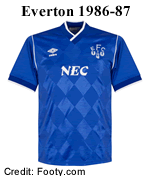 Increasingly the major sports wear manufacturers shifted production to Pakistan and the far-east where low labour costs and lax regulation enabled them to generate greater profits.
Increasingly the major sports wear manufacturers shifted production to Pakistan and the far-east where low labour costs and lax regulation enabled them to generate greater profits.
Digital Jacquard looms were used to create the distinctive shadow stripes, first worn by Tottenham Hotspur in their centenary season, 1982-83. These caught on quickly and over time manufacturers produced novel variations such as the diamond effect worn by Everton in 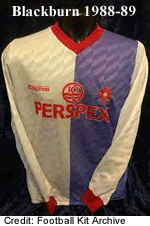 1986-87.
1986-87.
Towards the end of the decade textures became ever more complex as 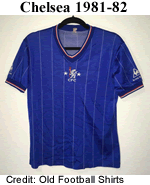 manufacturers experimented with the new technology. The zig-zag effect produced by Ellgren for Blackburn Rovers in 1988-89 is a good example.
manufacturers experimented with the new technology. The zig-zag effect produced by Ellgren for Blackburn Rovers in 1988-89 is a good example.
Direct dye sublimation was used to create the pinstriped shirt that swept through the football world and once again it was Le Coq Sportif who led the field, supplying the novel tops to Chelsea in 1981-82. The other suppliers were quick to respond, introducing their own versions the following season. Of these, Umbro's design for Liverpool was perhaps the most elegant and memorable.
Such was the fascination with pinstripes that they even 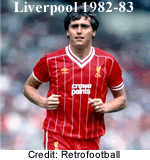 appeared on striped shirts such as those worn by West Bromwich Albion, when
appeared on striped shirts such as those worn by West Bromwich Albion, when 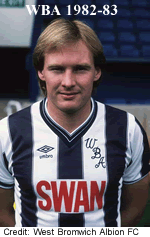 they became practically invisible.
they became practically invisible.
It is interesting to reflect that while the 1968 Design Copyright Act provided protection for individual kit designs this did not extend to design elements like shadow stripes or pinstripes. Rival companies were able to freely incorporate these elements into their own products and so they did. In the 1985-86 season 17 Football League clubs wore pinstriped shirts while another 17 boasted shadow stripes.
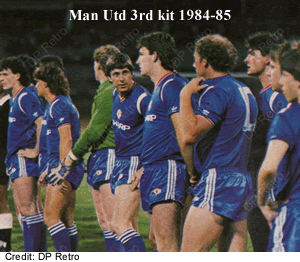 Flappy collars disappeared almost entirely and were replaced by Vee necks that often included complicated trim.
Flappy collars disappeared almost entirely and were replaced by Vee necks that often included complicated trim.
Historically clubs would retain a new kit for two or three seasons but by the middle of the decade the leading clubs were introducing new strips every year. In addition some clubs introduced third kits which could be called 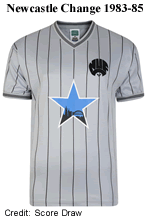 on when their first and second choice outfits both clashed with the home team. Manchester United were among the first to introduce third kits in the Seventies and throughout the Eighties they supplemented their traditional red/white first kit, white/black change with a blue alternative.
on when their first and second choice outfits both clashed with the home team. Manchester United were among the first to introduce third kits in the Seventies and throughout the Eighties they supplemented their traditional red/white first kit, white/black change with a blue alternative.
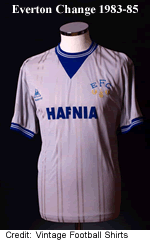 In 1983 Umbro provided Newcastle United with a change strip made of shiny polyester in silver-grey and black detailing. By coincidence, Le Coq Sportif delivered kit in a very similar colour to Everton that same season. Novelty being an important quality at the time, grey strips became very much the mode du jour and were ordered by more than a few clubs.
In 1983 Umbro provided Newcastle United with a change strip made of shiny polyester in silver-grey and black detailing. By coincidence, Le Coq Sportif delivered kit in a very similar colour to Everton that same season. Novelty being an important quality at the time, grey strips became very much the mode du jour and were ordered by more than a few clubs.
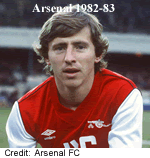 The addition of an extra, accent colour became popular in the middle of the decade. This was normally applied discretely in order to add a little extra contrast to one or more design features. For example, Arsenal's had navy piping along the shoulder seams as well as the side of the shorts, a detail that could only be seen from close range.
The addition of an extra, accent colour became popular in the middle of the decade. This was normally applied discretely in order to add a little extra contrast to one or more design features. For example, Arsenal's had navy piping along the shoulder seams as well as the side of the shorts, a detail that could only be seen from close range.
When Bolton Wanderers updated their crest in 1977 it included a red scroll so this was the natural choice when they decided to add an accent colour to their shirt. 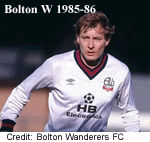 This has been more or less constantly present ever since. Although I doubt it was a factor, it's worth noting in passing that red featured prominently in the Trotters' colours in the 19th century.
This has been more or less constantly present ever since. Although I doubt it was a factor, it's worth noting in passing that red featured prominently in the Trotters' colours in the 19th century.
New Kids on the Block
Inspired perhaps by Admiral's success in the previous decade a lot of new brands began to appear driving an i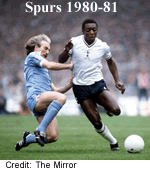 ncrease in competition and innovation in design.
ncrease in competition and innovation in design.
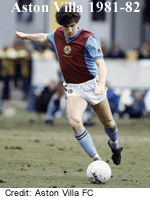 Some of the companies that emerged are still active today including the French company, Le Coq Sportif who replaced Admiral as Tottenham Hotspur's technical partner in 1980. Spurs won the FA Cup in 1981 wearing a typically sleek and elegant LCS design. The addition of light blue side panels to the torso of Aston Villa's 1981-82 strip was typical of Le Coq Sportif's approach at the time, which was to respect tradition while adding a touch of flair in their designs.
Some of the companies that emerged are still active today including the French company, Le Coq Sportif who replaced Admiral as Tottenham Hotspur's technical partner in 1980. Spurs won the FA Cup in 1981 wearing a typically sleek and elegant LCS design. The addition of light blue side panels to the torso of Aston Villa's 1981-82 strip was typical of Le Coq Sportif's approach at the time, which was to respect tradition while adding a touch of flair in their designs.
Le Coq Sportif's approach to Sunderland's 1981-82 strip was 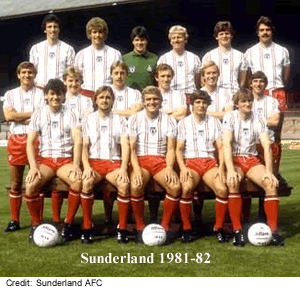 rather more radical and received mixed reactions at the time. Wearsiders are fiercely protective about their team's traditions and the switch to white shorts in the 60s was considererd a radical departure so this one probably went too far. It may be significant that unlike many other novel designs from the Eighties, it has never been revived.
rather more radical and received mixed reactions at the time. Wearsiders are fiercely protective about their team's traditions and the switch to white shorts in the 60s was considererd a radical departure so this one probably went too far. It may be significant that unlike many other novel designs from the Eighties, it has never been revived.
When Lawrie McMenemy persuaded European Footballer of the Year, Kevin Keegan, to join his Southampton team in 1980 it was regarded 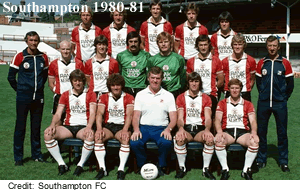 as a major coup. The team was kitted out by an unfamilar sportswear company from Oudenaarde in Belgium, Patrick (the company had changed its name from Patrice some time previously to give it international appeal). Patrick radically revised the Saints' stripes to create one of the most iconic and instantly recognisable strips of the period.
as a major coup. The team was kitted out by an unfamilar sportswear company from Oudenaarde in Belgium, Patrick (the company had changed its name from Patrice some time previously to give it international appeal). Patrick radically revised the Saints' stripes to create one of the most iconic and instantly recognisable strips of the period.
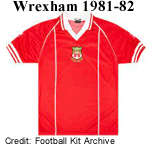 Patrick also provided Birmingham City, Newport County, Wrexham, Peterborough and Derby County among others with kits that were based on a single template, quite unusual for the time. The contrasting seams anticipate a design feature that would become a popular motif over the next couple of decades and can be justifiably considered to be ahead of their time.
Patrick also provided Birmingham City, Newport County, Wrexham, Peterborough and Derby County among others with kits that were based on a single template, quite unusual for the time. The contrasting seams anticipate a design feature that would become a popular motif over the next couple of decades and can be justifiably considered to be ahead of their time.
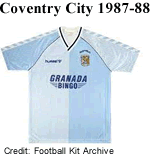 Patrick faded from view before the end of the decade although the brand coninued to pop up from time to time. The company still exists and still makes football attire for the general market but is now more focussed on sports leisure wear.
Patrick faded from view before the end of the decade although the brand coninued to pop up from time to time. The company still exists and still makes football attire for the general market but is now more focussed on sports leisure wear.
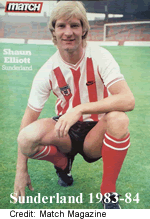 The Danish company, Hummel, made their first appearance in the UK with kits for Coventry City, Southampton and Aston Villa in 1987-88. These were based on the eye-catching design worn by the Danish national team in the 1986 World Cup. Hummel's signature chevron trim remains a familiar site in the UK to this day.
The Danish company, Hummel, made their first appearance in the UK with kits for Coventry City, Southampton and Aston Villa in 1987-88. These were based on the eye-catching design worn by the Danish national team in the 1986 World Cup. Hummel's signature chevron trim remains a familiar site in the UK to this day.
Nike made a fleeting appearance in the decade providing Sunderland's kit between 1983 and 1986, the first time that the American sportswear giant had sponsored a club in Europe. By today's standards there is nothing remarkable about this outfit although the plain white raglan sleeves were a novelty as was the reversal of club crest and maker's logo. What is curious is that Nike did not follow up this first step but instead focussed on building their brand among young people in the United States through celebrity endorsements. In the following decade they would be back with a vengeance and on their way to becoming a global brand.
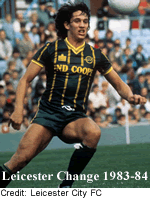 Having brought in the receivers in 1980, Admiral were declared bankrupt in 1982. The company re-emerged with new owners but the former glamour was gone and the lucrative contract to supply the England team's kit was drawing to a close. They did win back the contract to supply their local side Leicester City in 1983-84 but even this small victory turned to farce. Admiral's design featured royal blue shirts with white double pinstripes and was generaly popular. The change strip was in the same design but in the green and gold colours of their sponsor. The team lost 13 league and FA Cup games wearing this outfit and in the end the players refused to wear it.
Having brought in the receivers in 1980, Admiral were declared bankrupt in 1982. The company re-emerged with new owners but the former glamour was gone and the lucrative contract to supply the England team's kit was drawing to a close. They did win back the contract to supply their local side Leicester City in 1983-84 but even this small victory turned to farce. Admiral's design featured royal blue shirts with white double pinstripes and was generaly popular. The change strip was in the same design but in the green and gold colours of their sponsor. The team lost 13 league and FA Cup games wearing this outfit and in the end the players refused to wear it. 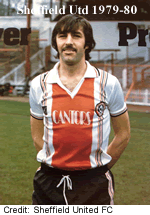 After a panicky telephone call from the club some boxes of plain red shirts were found in Admiral's factory. Seamstresses applied crests, sponsorship and squad numbers and the shirts were driven over to Filbert Street along with sets of white shorts and blue socks.
After a panicky telephone call from the club some boxes of plain red shirts were found in Admiral's factory. Seamstresses applied crests, sponsorship and squad numbers and the shirts were driven over to Filbert Street along with sets of white shorts and blue socks.
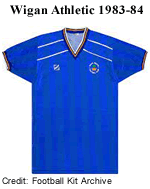 In 1979 the owner of a sports shop in Sheffield, The House of Barrington, decided to get involved in supplying teamwear to clubs in the Football League, starting with his home town team, Sheffield United. By adding the words "Official Teamster Top" to the initials of his store, Ken Barrington came up with the acronym HOBOTT which became the name of the new brand. The fine lines down the shirt were a distinctive feature of Hobott strips although they usually appeared on the sleeves and shoulders. In 1983-84 the company introduced a new feature, a pair of
In 1979 the owner of a sports shop in Sheffield, The House of Barrington, decided to get involved in supplying teamwear to clubs in the Football League, starting with his home town team, Sheffield United. By adding the words "Official Teamster Top" to the initials of his store, Ken Barrington came up with the acronym HOBOTT which became the name of the new brand. The fine lines down the shirt were a distinctive feature of Hobott strips although they usually appeared on the sleeves and shoulders. In 1983-84 the company introduced a new feature, a pair of 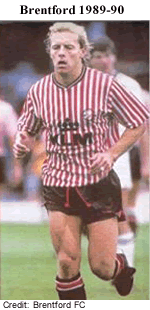 contrasting seams running from the collar to the sleeve and this became their signature motif.
contrasting seams running from the collar to the sleeve and this became their signature motif.
Over the course of the decade Hobott supplied kit to 17 Football League clubs, mainly in the lower divisions and most of them in the north of England. New technologies and competition from larger brands, who were beginning to transfer production to the Indian sub-continent and the Far East where labour costs were far cheaper, led to the company's demise. In 1989-90, Brentford became the last team to wear a Hobott strip.
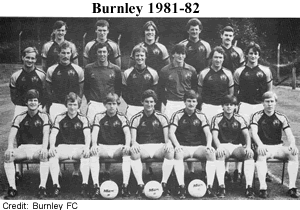 Spall, who are based in Bradford, appeared on the scene in 1981 when they supplied kits to Burnley. Their focus was on no-nonsense styling and they supplied more than 40 clubs in England and Scotland during the decade, mainly in the lower divisions.
Spall, who are based in Bradford, appeared on the scene in 1981 when they supplied kits to Burnley. Their focus was on no-nonsense styling and they supplied more than 40 clubs in England and Scotland during the decade, mainly in the lower divisions.
In 1986 Wolverhampton Wanderers were at their lowest ebb, languishing in the Fourth Division but the following season, 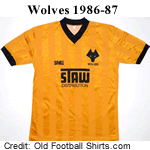 wearing their Spall kit, they won the Division Four title and the Sherpa Van Trophy into the bargain. This particular shirt included one of the definitive features of the decade, shadow stripes.
wearing their Spall kit, they won the Division Four title and the Sherpa Van Trophy into the bargain. This particular shirt included one of the definitive features of the decade, shadow stripes.
Although the Spall brand disappeared in 1990 the company have diversified and focussed on supplying sportswear to the trade. They continue to manufacture in the UK.
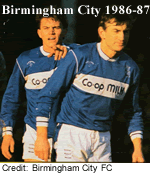 In 1986 the Lanarkshire company, Matchwinner, made their debut with kits for Birmingham City and St Johnstone. The Birmingham kit included several elements that would be commonplace in the Eighties, including a contrasting panel where the shirt sponsor would be more visible, coloured seams at the shoulder and a cross-over crew (or vee) neck. Their design for Dundee, which featured bold coloured bands across the top of the shirt proved
In 1986 the Lanarkshire company, Matchwinner, made their debut with kits for Birmingham City and St Johnstone. The Birmingham kit included several elements that would be commonplace in the Eighties, including a contrasting panel where the shirt sponsor would be more visible, coloured seams at the shoulder and a cross-over crew (or vee) neck. Their design for Dundee, which featured bold coloured bands across the top of the shirt proved 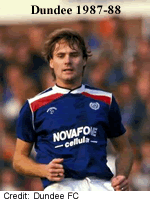 very popular and was adopted by Birmingham City, Hull City, Bolton Wanderers, Forfar Athletic and many others.
very popular and was adopted by Birmingham City, Hull City, Bolton Wanderers, Forfar Athletic and many others.
Between 1986 and 1999 Matchwinner supplied 45 clubs, evenly split between England and Scotland, including a number of very flamboyant outfits during the Nineties. What happened to the company after that is unclear. According to Companies House, they were reconstituted as Dunegold Ltd in 1997 but seem to have ceased production in 1999, after which they were listed as being dormant. The Matchwinner brand was aquired 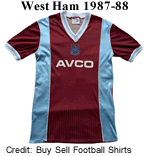 by Fourex Group Ltd in February 2023.
by Fourex Group Ltd in February 2023.
Scoreline became a familiar brand in the Eighties thanks in no small measure to their recruitment of two top flight clubs, West Ham United and Norwich City in 1987-88. These shirts illustrate how 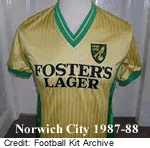 designers were beginning to explore the possibilities of the new technology and fabrics that had become available. Both shirts are made from shiny polyester with a fine shadow stripe sublimated into the fabric. There is fine detailing at the collar and cuffs and the West Ham top has a subtle white seam separating the claret and blue sections. Apart from the shiny fabric,
designers were beginning to explore the possibilities of the new technology and fabrics that had become available. Both shirts are made from shiny polyester with a fine shadow stripe sublimated into the fabric. There is fine detailing at the collar and cuffs and the West Ham top has a subtle white seam separating the claret and blue sections. Apart from the shiny fabric, 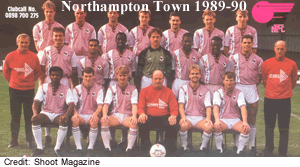 these are details that would be invisible at a distance and which were intended to be appreciated by the wearer. In other words these were tops designed with the adult replica shirt buyer in mind.
these are details that would be invisible at a distance and which were intended to be appreciated by the wearer. In other words these were tops designed with the adult replica shirt buyer in mind.
At their high point Scoreline had 22 teams on the books in 1989-90. Most of their designs were of good quality and consistent with their debut strips. The exception was the awful outfit worn by Northampton Town with its migraine-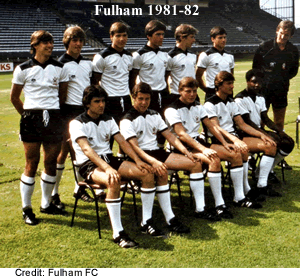 inducing interference pattern, a precursor to what was to come in the Nineties.
inducing interference pattern, a precursor to what was to come in the Nineties.
In 1990-91 Scoreline had 13 teams under contract but the following season they vanished without trace.
London based Osca Sportswear provided kit to ten members in the lower divisions of the Football League between 1981 and 1987. Their designs were strong and attractive without being spectacular and rested firmly on club tradition. Their 1981-82 design for Fulham added a black shoulder flash to the team's 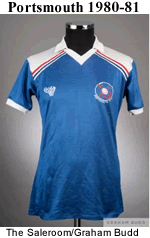 usual combination of white shirts and black shorts. Osca disappeared after 1987 and are currently listed as dormant by Companies House.
usual combination of white shirts and black shorts. Osca disappeared after 1987 and are currently listed as dormant by Companies House.
Gola are well known as producers of trainers, tracksuits and bags and have a history that goes back to 1905. In 1980 they made a foray into the world of football kit with an outfit for Portsmouth that added white shoulders trimmed in red, white and blue to Pompey's traditional blue tops. Teamed with white shorts and their signature red socks, this was a really fine design. The only fly in the ointment was the new crest which replaced the moon and star badge that had been worn proudly since 1912 but such make overs are generally the initiative of the club rather than their kit provider. Gola contributed a few more kits to the Football League in the early Nineties before returning to their core business.
Decline and Disaster
The Eighties were a dark decade for professional football in England which has been characterised as a period of managed decline when matches were played in decrepit death-trap stadiums. Average attendances across the Football League had dropped steadily from 22,318 in 1949 to 8,132 in 1986, a symptom of football's declining attraction faced with the growth of television, cinema and other entertainments.
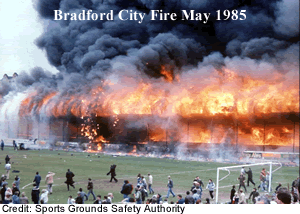 The main stands at many clubs were poorly maintained, ancient wooden structures. The fire that destroyed the main stand at Southport FC on Boxing Day 1966 should have sounded a warning but since it was empty at the time it was ignored. On 11 May 1985 a discarded cigarette ignited accumulated litter below the main stand at Bradford City starting a small fire that engulfed the structure in less than four minutes, killing 56 and injuring 256.
The main stands at many clubs were poorly maintained, ancient wooden structures. The fire that destroyed the main stand at Southport FC on Boxing Day 1966 should have sounded a warning but since it was empty at the time it was ignored. On 11 May 1985 a discarded cigarette ignited accumulated litter below the main stand at Bradford City starting a small fire that engulfed the structure in less than four minutes, killing 56 and injuring 256.
Against a background of rising unemployment, hooliganism became endemic, often orchestrated by organised "firms" with links to far-right neo-fascist groups, further deterring law-abiding supporters and families from attending matches. The 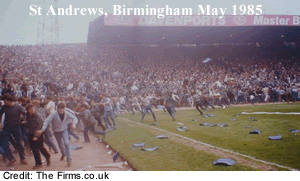 response of the Conservative government and the police was heavy-handed. Violence at and around football stadia was seen as a law and order issue that had to be clamped down on rather than a symptom of economic and social problems. The response was to erect high fences and create pens where supporters could be herded like cattle and segregated and policed aggressively.
response of the Conservative government and the police was heavy-handed. Violence at and around football stadia was seen as a law and order issue that had to be clamped down on rather than a symptom of economic and social problems. The response was to erect high fences and create pens where supporters could be herded like cattle and segregated and policed aggressively.
On 29 May 1985 Liverpool were in Brussels to defend their European Cup against Juventus. The 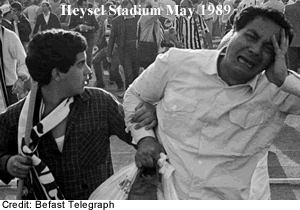 match would be played in the 55-year old Heysel Stadium that was literally crumbling. Some sections of the cinder-block outer wall were in such a poor state that supporters without tickets were able kick holes in it to gain admission. An hour before kick-off trouble flared in a section of the ground where supporters of the rival clubs were separated by a thinly policed temporary fence and Liverpool supporters tried to reach the Italian fans. In the riot that followed Juventus supporters were crushed against a concrete wall which collapsed, killing 39. As a consequence English clubs were banned from European competition for the next five years.
match would be played in the 55-year old Heysel Stadium that was literally crumbling. Some sections of the cinder-block outer wall were in such a poor state that supporters without tickets were able kick holes in it to gain admission. An hour before kick-off trouble flared in a section of the ground where supporters of the rival clubs were separated by a thinly policed temporary fence and Liverpool supporters tried to reach the Italian fans. In the riot that followed Juventus supporters were crushed against a concrete wall which collapsed, killing 39. As a consequence English clubs were banned from European competition for the next five years.
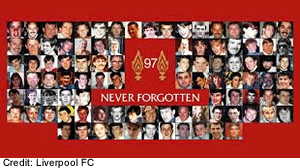 The appalling consequences of the UK governments heavy-handed handling of football supporters became apparent on 15 April 1989 in the FA Cup semi-final at Hillsborough between Liverpool and Nottingham Forest. A crush developed in the two pens allocated to Liverpool supporters after the police commander ordered a gate to be opened to relieve overcrowding outside the ground. The influx into the already crowded pens caused spectators to be crushed against the perimeter fences. Despite desperate pleas for help and the obvious distress of those trapped, the police initally refused to unlock the gates that would have allowed fans to escape onto the pitch. The final death toll was 97.
The appalling consequences of the UK governments heavy-handed handling of football supporters became apparent on 15 April 1989 in the FA Cup semi-final at Hillsborough between Liverpool and Nottingham Forest. A crush developed in the two pens allocated to Liverpool supporters after the police commander ordered a gate to be opened to relieve overcrowding outside the ground. The influx into the already crowded pens caused spectators to be crushed against the perimeter fences. Despite desperate pleas for help and the obvious distress of those trapped, the police initally refused to unlock the gates that would have allowed fans to escape onto the pitch. The final death toll was 97.
© Dave Moor (2024)